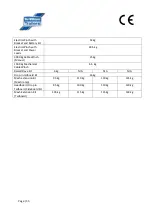
Page | 45
•
DO NOT jack under the spring, near the centre of the axle beam or near the centre of any
cross-member.
•
Unless the trailer is unladen it should always be coupled to an appropriately rated towing
vehicle when changing a wheel. Laden trailers should not be jacked up with the jockey wheel
supporting the front of the trailer.
•
With the damaged wheel off the ground and the trailer handbrake on, release the wheel-
bolts. If right hand wheel is being removed, it is likely that the wheel will rotate a short
distance as the brakes go into “auto
-
reverse” and come on again.
•
If the trailer brakes are not capable of resisting the release torque applied to the wheel bolts
without rotating then the brakes are out of adjustment. In this event the trailer should be
lowered until there is sufficient ground contact to resist wheel rotation. Do not attempt to
adjust the brakes of a laden trailer while it is jacked up.
•
Note: Loosening the wheel bolts while the full laden weight is on the wheel will result in
damage to the wheel.
•
Place the removed wheel bolts where the threads will not be contaminated with dirt.
•
Remove the damaged wheel. This will normally be straight-forwards. However, in the
particular case of the CT177, the wheel can only be removed if the bottom of the wheel is
pushed under the trailer, allowing the top of the wheel to fall out between the side plate and
the brake drum. Refitting a CT177 wheel requires the reverse sequence.
•
Clean the face of the hub and the back face of the wheel of any rust, dirt, flaked paint, grease
or any other contaminant. This is very important.
•
Fit the spare wheel and start all the wheel bolts by hand. Starting the wheel bolts by putting
the wheel bolt in a pneumatic gun could cost a replacement hub. Cross-threaded hubs cannot
be salvaged.
•
The initial tightening procedure is very important if wheel vibration on the unladen trailer is to
be avoided. Position the wheel and drum such that, for a 5-stud wheel, there is a wheel bolt at
top centre. Take the weight of the wheel off the wheel bolts
–
a lever placed under the wheel
if available
–
and just
“nip”
each wheel bolt with a hand wrench starting at the
10 o’clock
then
2 o’clock positions.
Done correctly the wheel is now centred.
•
Progressively tighten each wheel bolt
, starting at the ten o’clock position and going around
clockwise to every other (alternate) wheel bolt until all are at the specified torque: 110 Nm
(81 lbf.ft). Ideally there should be three torque increments up to the final torque.
•
In the case of 4-stud wheels the wheel should also be positioned with a stud-hole at top
centre, the weight of the wheel should also be supported and the first two wheel bolts to be
nipped and subsequently tightened should be those at 9 o’clock and 3 o’clock. For 4
-bolt
wheels the tightening torque is 88 Nm (65 lbf.ft).











































